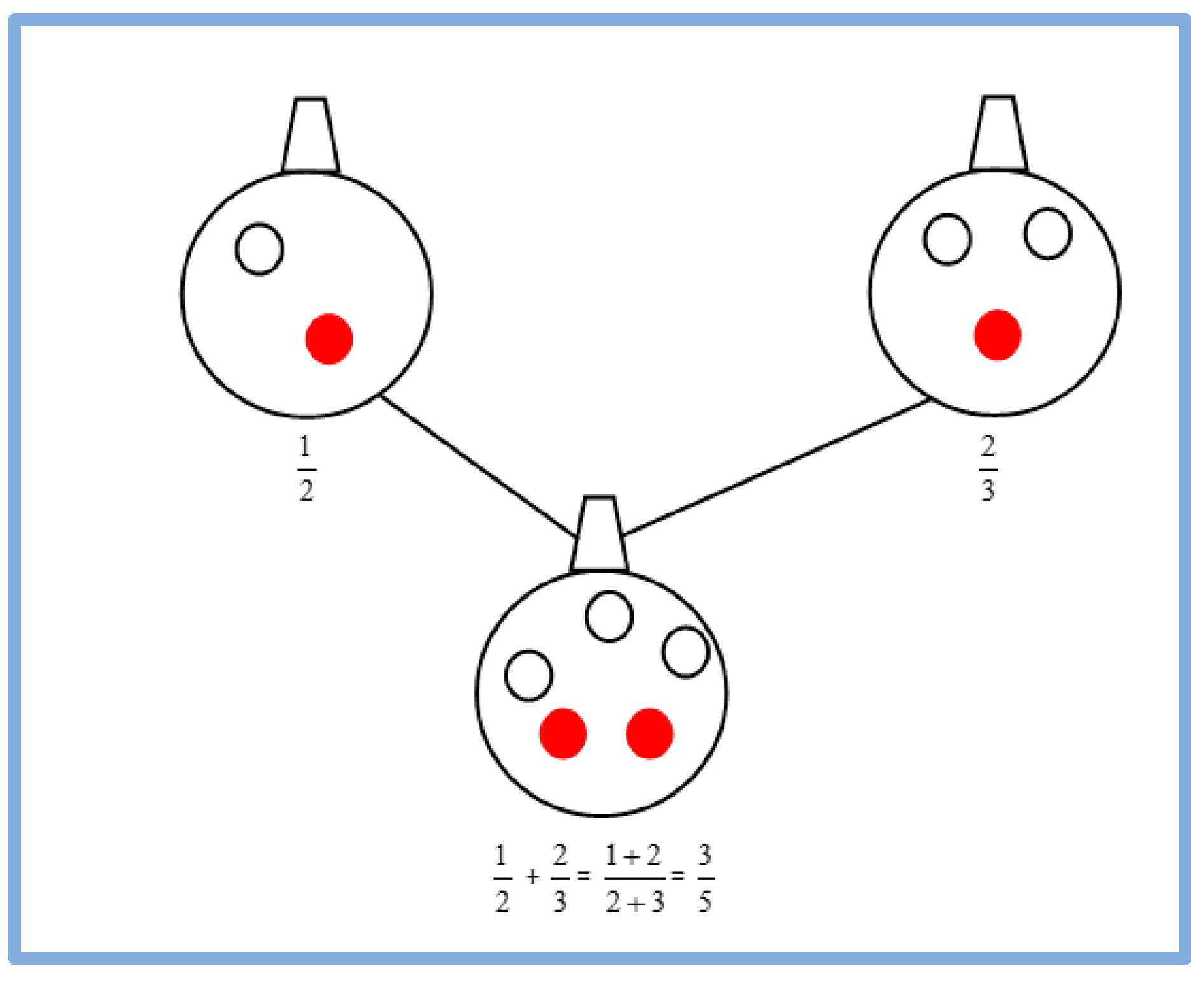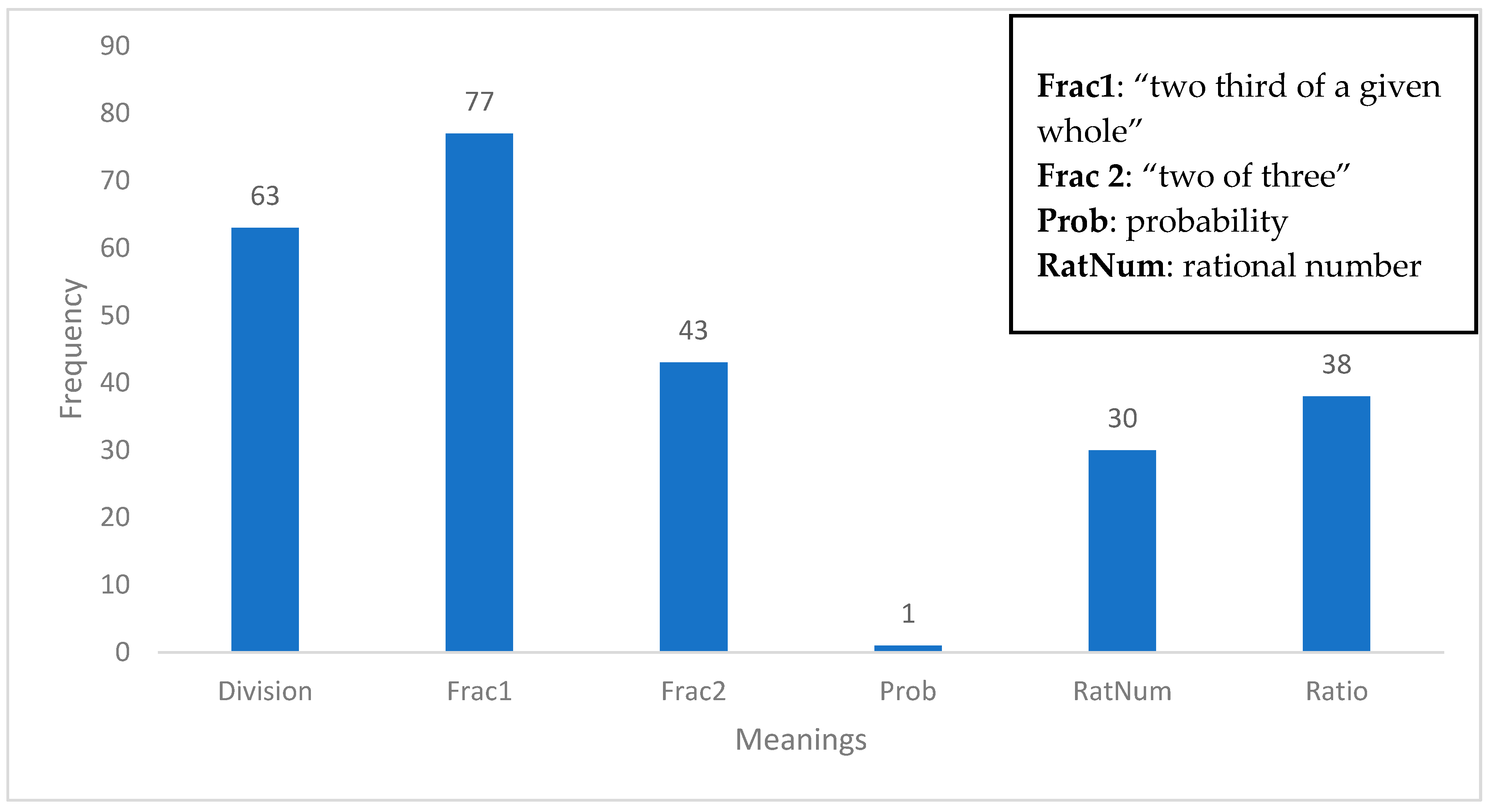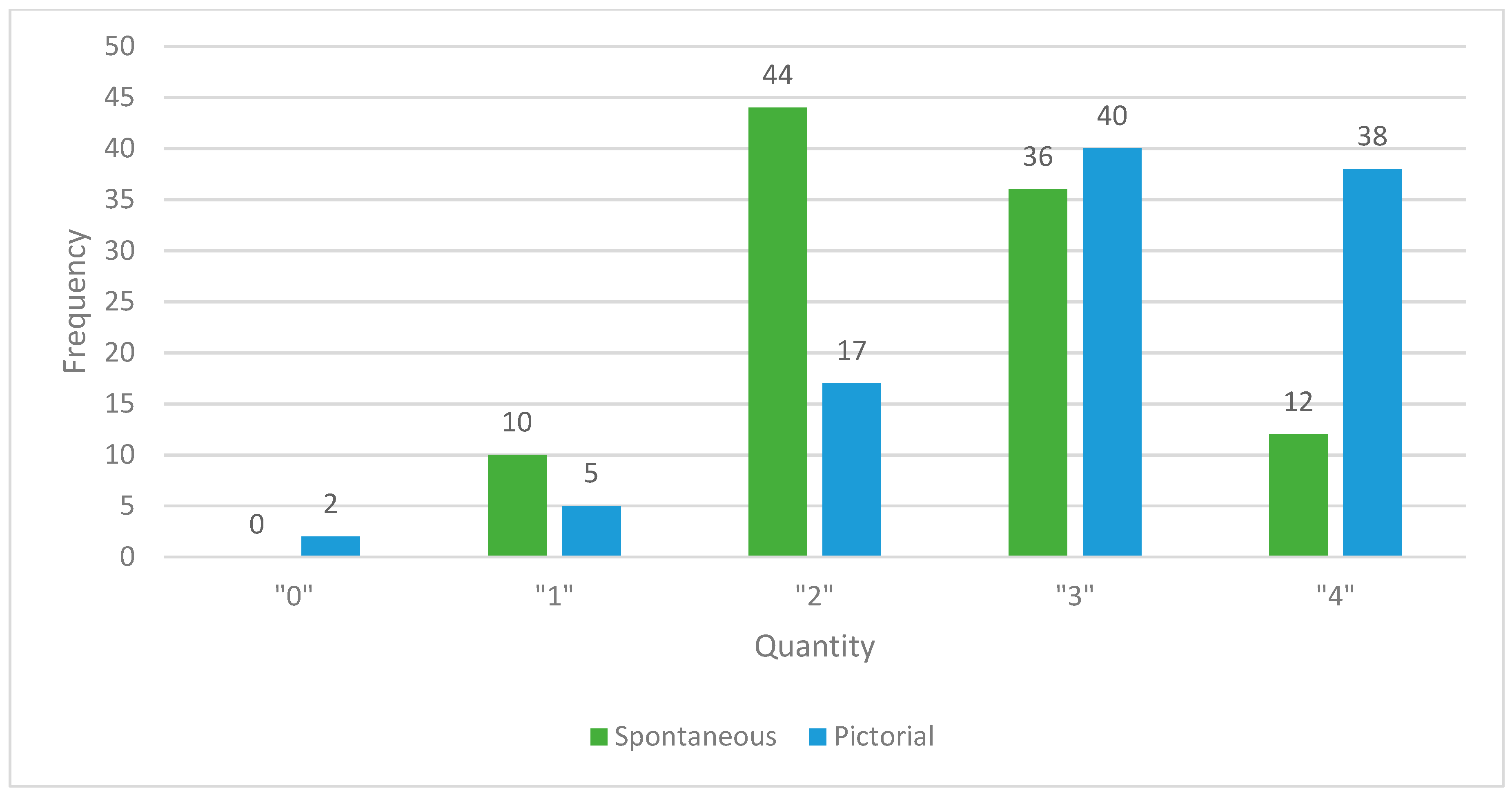Sustainability Development in Mathematics Education—A Case Study of What Kind of Meanings Do Prospective Class Teachers Find for the Mathematical Symbol “23”?
Abstract
:1. Introduction
1.1. Sustainable Development of Education
1.2. The Bases of Sustainable Development in Mathematics Education
1.3. A Case: Fractions and Meanings of Symbol “a/b”
2. Theoretical Background
2.1. Multiple Meanings of Symbol “a/b” in School Mathematics
2.2. The Role of Mathematics Textbooks and Teachers
2.3. Meaning Making of the Concept
3. Research Questions and Data Collection
3.1. Research Questions
- 1)
- What meanings do students give spontaneously for the symbol “2/3”?
- 2)
- What relationships do students find for the given pictures and the symbol “2/3”?
- 3)
- What kind of influences has the multi-semiotic approach to students’ interpretations?
3.2. Data Collection
- 1)
- On the first page, the students gave their opinions in the open question about what different meanings (e.g., fraction, division, ratio, etc.) the mathematical symbol “2/3” can have. Several lines were provided for the answers.
- 2)
- On the second page, the students were asked to describe in natural language (Finnish) how the pictures A–D (Figure 1) are connected to the mathematical symbol “2/3”. The students could give one or more descriptions of the connections.
- 3)
- On the third page, there was a mathematical problem, including the picture and the mathematical solution (Figure 2). The student’s task was to explain the solution processes by natural language, and to discover whether there were any mistakes in the presentation.
4. Results
- 1)
- Division: “Two divided by three: two pizzas to be divided into three people.” (Student 89),
- 2)
- Fraction 1: “In the test I got two thirds of answers correct”. (Student 55),
- 3)
- Fraction 2: “Two out of three. Pekka has eaten two pizza pieces from three.” (Student 87),
- 4)
- Probability: “Can be used to describe probability.” (Student 76),
- 5)
- Rational number: “0.66…” (Student 92),
- 6)
- Ratio: “You’ll get good juice if you put 2 dl concentrate and 3 dl water” (Student 57).
5. Conclusions and Discussion
Author Contributions
Funding
Conflicts of Interest
References
- Zehetmeier, S.; Krainer, K. Ways of promoting the sustainability of mathematics teachers’ professional development. ZDM Math. Educ. 2011, 43, 875–887. [Google Scholar] [CrossRef]
- UN. The 2030 Agenda for Sustainable Development. Sustainable Development Goals. 2018. Available online: https://sustainabledevelopment.un.org/sdgs (accessed on 15 August 2018).
- Díez-Palomar, J.; de Sanmamed, A.F.F.; García-Carrión, R.; Molina-Roldán, S. Pathways to equitable and sustainable education through the inclusion of roma students in learning mathematics. MDPI Sustain. 2018, 10, 2191. [Google Scholar] [CrossRef]
- Shulman, L.S. Those who understand: Knowledge growth in teaching. Educ. Res. 1986, 15, 4–14. [Google Scholar] [CrossRef]
- Opetushallitus. Finnish Core Curriculum for Basic Education 2014. Available online: http://www.oph.fi/ops2016/perusteet (accessed on 15 August 2018).
- Joutsenlahti, J.; Vainionpää, J. Oppimateriaali matematiikan opetuksessa ja osaamisessa. In Miten Matematiikan Taidot kehittyvät? Matematiikan Oppimistulokset Peruskoulun Viidennen Vuosiluokan Jälkeen Vuonna 2008; Niemi, T.E.K., Metsämuuronen, J., Eds.; Opetushallitus, Koulutuksen Seurantaraportti: Helsinki, Finland, 2010; Volume 2, pp. 137–148. [Google Scholar]
- Petoz, P.; Reid, A. What on earth is sustainability in mathematics? N. Z. J. Math. 2003, 32, 135–144. [Google Scholar]
- Lortie-Forgues, H.; Tian, J.; Siegler, R.S. Why Is Learning Fraction and Decimal Arithmetic So Difficult? Dev. Rev. 2015, 38, 201–221. [Google Scholar] [CrossRef]
- Matematiikan Oppimistulokset Peruskoulun Viidennen Vuosiluokan Jälkeen Vuonna 2008; Opetushallitus: Helsinki, Finland, 2010; pp. 137–148.
- Prediger, S.; Wessel, L. Fostering German-language learners’ constructions of meanings for fractions—Design effects of a language- and mathematics integrated intervention. Math. Educ. Res. J. 2013, 25, 435–456. [Google Scholar] [CrossRef]
- Mullis, I.V.S.; Martin, M.O.; Foy, P. TIMSS 2007 International Mathematics Report: Findings from IEA’s Trends in International Mathematics and Science Study at the Fourth and Eighth Grades; Chestnut Hill: Boston College, MA, USA, 2008. [Google Scholar]
- Park, J.; Güler, B.; McGrory, R. Teaching prospective teachers about fractions: historical and pedagogical perspectives. Educ. Stud. Math. 2013, 82, 455–479. [Google Scholar] [CrossRef]
- Iskenderoglu, T.A. Multiplication and division problems posed by pre-service elementary mathematics teachers about fraction topic. In Proceedings of the 40th Conference of the International Group for the Psychology of Mathematics Education, Szeged, Hungary, 3–7 August 2016; Csíkos, C., Rausch, A., Szitányi, J., Eds.; PME: Szeged, Hungary, 2016; Volume 2, pp. 35–42. [Google Scholar]
- Joutsenlahti, J.; Perkkilä, P.; Tossavainen, T. Näytteitä murtoluvun käsitteestä eri aikakausien oppikirjoissa. In Proceedings of the Annual FMSERA Symposium 2016, Joensuu, Finland, 27–28 October 2016; Asikainen, M., Hirvonen, P., Eds.; pp. 99–109. [Google Scholar]
- Merenluoto, K. Matkalla käsitteellisen muutoksen prosessikuvaukseen matematiikassa. On the way to the process description of conceptual change in mathematics. In Kasvatuksen Yhteisöt—Uupumusta, Häirintää vai Yhteisöllistä Kasvua? Sinevaara-Niskanen, H., Rajala, R., Eds.; Lapin Yliopiston Kasvatustieteellisiä Julkaisuja: Turku, Finland, 2006; pp. 58–71. [Google Scholar]
- Vosniadou, S. Conceptual change research: state of art and future directions. In New Perspectives on Conceptual Change; Schnotz, W., Vosniadou, S., Carretero, M., Eds.; Elsevier Science: Killington/Oxford, UK, 1999; pp. 3–14. [Google Scholar]
- Vosniadou, S. Capturing and modelling the process of conceptual change. Learn. Instr. 1994, 4, 45–69. [Google Scholar] [CrossRef]
- Vamvakoussi, X.; Vosniadou, S. What mental models do students use regarding the structure of the domain of rational numbers? In International Group of the Psychology of Mathematics Education, Proceedings of the 26th Annual Conference, Norwich, UK, 21–26 July 2002; Cockburn, A.C., Nardi, E., Eds.; University of East Anglia: Norwich, UK, 2002; pp. 1–326. [Google Scholar]
- Valverde, G.A.; Bianchi, L.J.; Wolfe, R.G.; Schmidt, W.H.; Houang, R.T. According to the Book: Using TIMSS to Investigate the Translation of Policy into Practice through the World of Textbooks; Kluwer: Dordrecht, The Netherlands, 2002. [Google Scholar]
- Viholainen, A.; Partanen, M.; Piiroinen, J.; Asikainen, M.; Hirvonen, P.E. The role of textbooks in Finnish upper secondary school mathematics: theory, examples and exercises. Nordic Stud. Math. Educ. 2015, 20, 157–178. [Google Scholar]
- Holmlund, A. Lärobokens Betydelse vid Lektionsplanering: En Intervjustudie med åtta Finska och Svenska Matematiklärare [The Importance of Textbook on Planning of Lessons: An Interview Study with Eight Finnish and Swedish Mathematics Teachers]. Bachelor’s Thesis, University of Gothenburg, Gothenburg, Sweden, 2013. Available online: http://ncm.gu.se/media/luma/GE-2013/holmlund.pdf (accessed on 15 August 2018).
- Perkkilä, P. Oppikirja ja uskomukset alkuopettajien matematiikan opetuksessa [Textbook and beliefs in teaching first- and second-grade mathematics]. In Tutkimus Kouluopetuksen Kehittämisessä [Research in the Development of School Teaching]; Ahtineva, A., Ed.; Publications of the Faculty of Education, University of Turku: Turku, Finland, 2001; Volume 17, pp. 112–125. [Google Scholar]
- Pantziara, M.; Philippou, G. Levels of students’ “conception” of fractions. Educ. Stud. Math. 2012, 79, 61–68. [Google Scholar] [CrossRef]
- Stewart, V. Making Sense of Student’s Understanding of Fractions: An Exploratory Study of Sixth Graders’ Construction of Fraction Concepts through the Use of Physical Referents and Real-World Representations. 2005. Available online: http://purl.flvc.org/fsu/fd/FSU_migr_etd-0390 (accessed on 15 August 2018).
- Mikkilä-Erdmann, M.; Olkinuora, E.; Mattila, E. Muuttuneet käsitykset oppimisesta ja opettamisesta—Haaste oppikirjoille [Changed conceptions of learning and teaching—A challenge for textbooks]. Kasvatus 1999, 30, 436–449. [Google Scholar]
- Beckmann, S. Mathematics for Elementary Teachers, 2nd ed.; Addison Wesley: Boston, MA, USA, 2008. [Google Scholar]
- Siegler, R.S.; Fazio, L.K.; Bailey, D.H.; Zhou, X. Fractions: The new frontier for theories for numerical development. Trends Cogn. Sci. 2013, 17, 13–19. [Google Scholar] [CrossRef] [PubMed]
- Joutsenlahti, J.; Kulju, P. Multimodal languaging as a pedagogical model—A case study of the concept of division in school mathematics. Educ. Sci. 2017, 7, 9. [Google Scholar] [CrossRef]
- Berger, M. Reading and learning from Mathematics textbooks: an analytic framework. In Proceedings of the 40th Conference of the International Group for the Psychology of Mathematics Education, Szeged, Hungary, 3–7 August 2016; Csíkos, C., Rausch, A., Szitányi, J., Eds.; PME: Szeged, Hungary, 2016; Volume 2, pp. 83–90. [Google Scholar]
- Lepik, M.; Grevholm, B.; Viholainen, A. Using textbooks in the mathematics classroom—The teachers’ view. Nordic Stud. Math. Educ. 2015, 20, 129–156. [Google Scholar]
- Silver, E.A. Cross-national comparisons of mathematics curriculum materials: what might we learn? ZDM Int. J. Math. Educ. 2009, 41, 827–832. [Google Scholar] [CrossRef]
- Törnroos, J. Mathematics textbooks, opportunity to learn and student achievement. Stud. Educ. Eval. 2005, 31, 315–327. [Google Scholar] [CrossRef]
- Perkkilä, P. Opettajien matematiikkauskomukset ja matematiikan oppikirjan merkitys alkuopetuksessa. In Jyväskylä Studies in Education, Psychology and Social Research; Jyväskylän yliopisto: Jyväskylä, Finland, 2002. [Google Scholar]
- Morgan, C. The place of pupil writing in learning, teaching and assessing mathematics. In Issues in Mathematics Teaching; Gates, P., Ed.; Routledge: London, UK, 2001; pp. 234–244. [Google Scholar]
- Pimm, D. Speaking Mathematically: Communication in Mathematics Classrooms; Routledge & Kegan Paul: London, UK, 1987. [Google Scholar]
- Lemke, J. Mathematics in the Middle: Measure, Picture, Gesture, Sign and Word. In Educational Perspectives on Mathematics as Semiosis: From Thinking to Interpreting to Knowing; Andersson, M., Saenz-Ludlow, A., Zellweger, S., Cifarelli, V., Eds.; Legas Publishing: Ottawa, ON, Canada, 2002; pp. 215–243. [Google Scholar]
- Schleppegrell, M. Language in mathematics teaching and learning: a research review. In Language and Mathematics Education; Moschkovich, J.N., Ed.; Information Age Publishing, Inc.: Charlotte, NC, USA, 2010; pp. 73–112. [Google Scholar]
- Bauersfeld, H. Language games in the mathematics classroom: Their function and their effects. In The Emergence of Mathematical Meaning: Interaction in Classroom Cultures; Cobb, P., Bauersfeld, H., Eds.; Erlbaum: Hillsdale, NJ, USA, 1995; pp. 271–294. [Google Scholar]
- Joutsenlahti, J. Matematiikan kirjallinen kielentäminen lukiomatematiikassa. In Ajankohtaista Matemaattisten Aineiden Opetuksen ja Oppimisen Tutkimuksessa, Proceedings of the Annual Symposium of the Finnish Mathematics and Science Education Research Association, Joensuu, Finland, 22–23 October 2009; Asikainen, M., Hirvonen, P., Sormunen, K., Eds.; Kopijyvä: Joensuu, Finland, 2009; pp. 3–15. [Google Scholar]
- Duvall, R. Understanding the Mathematical Way of Thinking—The Registers of Semiotic Representations; Springer International Publishing AG: Cham, Switzerland, 2017. [Google Scholar]
- Kalantzis, M.; Cope, B. Literacies; Cambridge University Press: Cambridge, UK, 2012. [Google Scholar]
- Perkkilä, P.; Joutsenlahti, J.; Sarenius, V.-M. Peruskoulun matematiikan oppikirjat osana oppimateriaalitutkimusta. In Matematiikka ja Oppiminen; Joutsenlahti, J., Silfverberg, H., Räsänen, P., Eds.; NMI: Jyväskylä, Finland, 2018; pp. 344–364. [Google Scholar]




| Picture | A | B | C | D |
|---|---|---|---|---|
| Frac1 | 59 | 0 | 18 | 45 |
| Frac2 | 38 | 0 | 0 | 0 |
| Ratio | 2 | 43 | 0 | 0 |
| Division | 1 | 1 | 56 | 1 |
| Rational | 3 | 0 | 1 | 41 |
| Other | 16 | 49 | 15 | 8 |
| Theme | Category | f | Example |
|---|---|---|---|
| Meanings of the symbols “” and “” | the ratio of the number of white balls to the number of balls (1a) | 7 | Ratio between white balls to red balls (two big balls in the top ok). (Student 98) |
| white balls one-two of all balls (1b) | 19 | The white balls represent the numerator, i.e., how many parts have been taken, and all the balls represent the denominator, i.e., how many parts are in total. (Student 96) | |
| one white ball of two balls (1c) | 26 | One of the two balls is red and two of the three balls are white. (Student 92) | |
| Conceptual approach to the expressions | “” is not correct expression for addition of two ratios (2a) | 2 | The pupil has mixed with the amount of proportionality that is significant to each other. In the above fractions, the numerator does not, for example, express the number of things per se, but it is the ratio representing the proportion of the total or proportionality relative to the total. Therefore, before adding one would have needed to find common denominators rather than adding the denominators together. (Student 93) |
| “” is not correct addition, because the fractions have been taken from different totals (2b) | 2 | The balls are combined, that is, the whole has changed into five balls (combined the amounts of balls in the two bigger balls), of which white is still 1 + 2 i.e., a total of 3 (the same amount as in the two big balls in total). Overall, the total number of small balls has changed. (Student 88) | |
| Procedural approach to the expressions | find the mistake in the equation “ = ” (3a) | 31 | In the picture under the third ball the fractions are added together without considering the whole. You cannot add fractions with different denominators together before finding them common denominators. (Student 84) |
| the expression “” is argumented correctly (3b) | 19 | In the picture, at point C the balls of points A and B are combined, and this forms a new whole at point C. When counting the selected white balls of A and B, three balls are obtained. Unselected balls = 2. The total amount of balls at point C is 5, so three white balls out of five have been selected in total. (Student 89) | |
| The sum should be (3c) | 18 | Oh! This math task + is incorrectly calculated. If the denominators are different, then to add fractions you must first get common denominators. Then you can add the fractions + = + = = 1 (Student 79) | |
| The sum is , but there is something wrong with the figure (3d) | 13 | In the picture the fractionsandare added together but in the wrong way. Fractions must have the same denominators before adding. After finding denominators they can be counted together. + = + = = 1 In the picture the balls are counted together, but not as fractions. (Student 85) | |
| Do not find any problems in the presentation | Accept the presentation (4a) | 35 | This illustrates addition of fractions and especially that why you can add numerators together and denominators together. At first, I did not understand what it was all about when I was just staring at red balls. It would have been clearer if the colored balls had described the amount of numerator. On the other hand, this version made me think more. (Student 77) |
© 2019 by the authors. Licensee MDPI, Basel, Switzerland. This article is an open access article distributed under the terms and conditions of the Creative Commons Attribution (CC BY) license (http://creativecommons.org/licenses/by/4.0/).
Share and Cite
Joutsenlahti, J.; Perkkilä, P. Sustainability Development in Mathematics Education—A Case Study of What Kind of Meanings Do Prospective Class Teachers Find for the Mathematical Symbol “23”? Sustainability 2019, 11, 457. https://doi.org/10.3390/su11020457
Joutsenlahti J, Perkkilä P. Sustainability Development in Mathematics Education—A Case Study of What Kind of Meanings Do Prospective Class Teachers Find for the Mathematical Symbol “23”? Sustainability. 2019; 11(2):457. https://doi.org/10.3390/su11020457
Chicago/Turabian StyleJoutsenlahti, Jorma, and Päivi Perkkilä. 2019. "Sustainability Development in Mathematics Education—A Case Study of What Kind of Meanings Do Prospective Class Teachers Find for the Mathematical Symbol “23”?" Sustainability 11, no. 2: 457. https://doi.org/10.3390/su11020457
APA StyleJoutsenlahti, J., & Perkkilä, P. (2019). Sustainability Development in Mathematics Education—A Case Study of What Kind of Meanings Do Prospective Class Teachers Find for the Mathematical Symbol “23”? Sustainability, 11(2), 457. https://doi.org/10.3390/su11020457




